Improving Personal Narratives with a Focus on Seed Stories
When I first started teaching personal narratives, my students thought the assignment was: “tell me every single thing that happened from the moment you woke up to the moment you went to bed.” Needless to say, their “stories” read more like laundry lists. After a lot of trial and error, I found that using the watermelon and seed analogy finally clicked with them. Suddenly, they understood they didn’t need the whole watermelon – just one small, meaningful seed of a story.
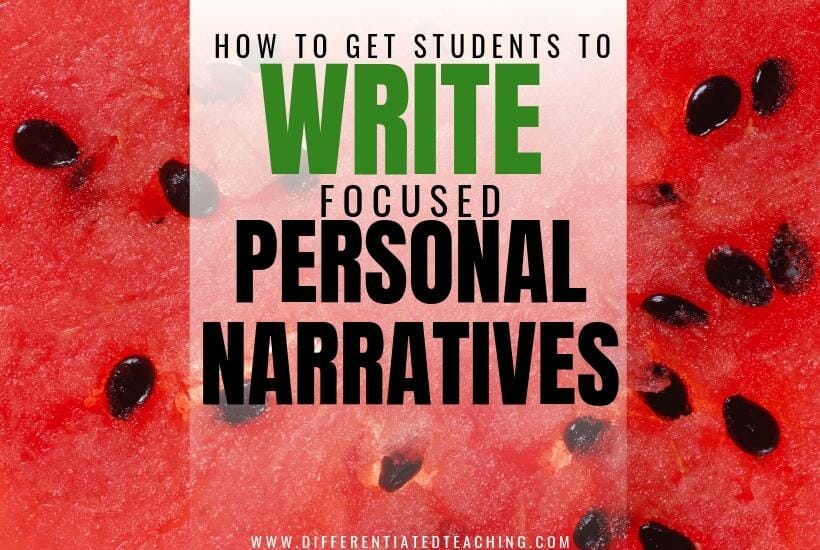
One of the biggest barriers I’ve found with narrative writing is that students want to tell me everything. You’ve probably been there too. A learner sits down to write about their trip to Disney, and before you know it, their story starts with packing the car and doesn’t end until they’re back home, exhausted, with mouse ears on the dresser.
Instead of zooming in on the magical moment, the squeal as they spotted Cinderella’s castle, the taste of cotton candy melting on their tongue, we end up with a laundry list of events. Fun for them, but not so fun to read. So how do we help kids realize they don’t need to write all the things…just the moment that matters?
What is a small moment in writing terms?
A “small moment” is simply focusing a story on one specific experience instead of the entire event. Rather than retelling everything that happened, students zoom in on the sights, sounds, thoughts, and feelings of a single point in time.
Easy Ways to Explain It
- Watermelon Analogy: The whole watermelon is the big event. The seeds are the smaller, story-worthy moments inside.
- Pizza Analogy: The full pizza is the event. Each slice (or even a topping) is a moment worth telling.
Why It Works
When students learn to write small moments, their stories move from lists of “and then… and then…” to detailed scenes the reader can actually picture. Instead of skimming across everything, they dive deeper into one meaningful part.
What to Expect
This isn’t instant. Most students need multiple lessons and lots of modeling before they really understand how to zoom in. The good news? Once they get it, their writing becomes more vivid and engaging.
Ideas for Teaching Personal Narratives & Small Moments
1. Start with a Hands-On Visual
Bring in a watermelon and slice it open!
- Have students describe the whole watermelon. Talk about how heavy it would be to carry around all day.
- Then show the slices and seeds. Compare carrying a seed to carrying the whole watermelon—it’s much easier.
- Connect this to writing: the watermelon is a big event, but the seeds are the focused moments that make the story meaningful.
Helpful Hint: Don’t buy a seedless watermelon (I learned this the hard way). If you do, connect it back to writing: sometimes authors forget the “seeds,” and their stories end up less interesting.
2. Use a Concept Sort
Before students write, let them practice identifying what counts as a “small moment.”
- Give examples and non-examples in a sort activity.
- Work through a group sort first, then give individual sorts to check for understanding.
- This makes misconceptions visible early and helps students spot the “seed” moments in their own lives.
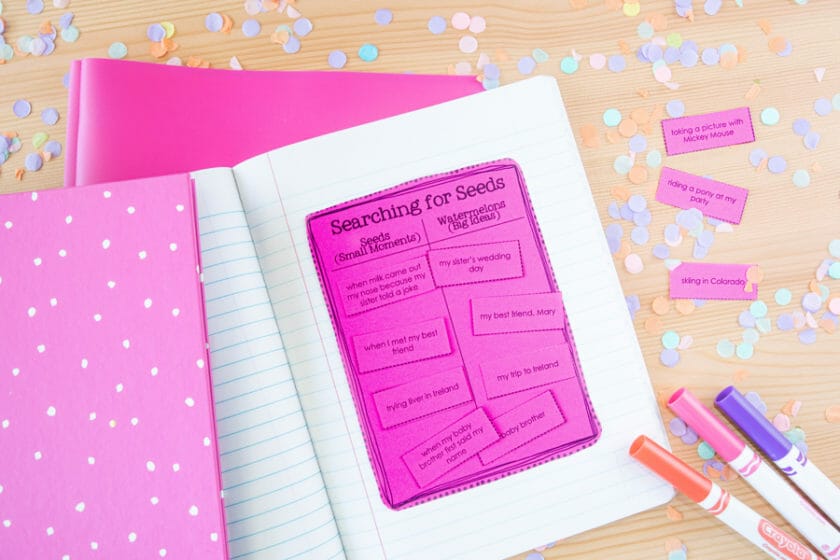
3. Brainstorm watermelon and seed ideas.
Students usually start the year by creating idea banks—lists of people, places, and important events. Turn those into small-moment practice.
- Pick a big “watermelon idea” from their list.
- Have them identify 2–4 “seeds” (smaller moments) inside it.
- Use a graphic organizer to help them connect the big event to the smaller, story-worthy moments.
Tip: Let students share their organizers. Seeing how peers break big events into seeds helps everyone get better at it.
How to Strengthen Narrative Writing After Small Moments
Build Emotion Into Stories
Personal narratives should make the reader feel like they were there. But when students write about huge events, they skip details just to “get it done.” Focusing on small moments is step one. The next step is teaching them how to layer in emotion and description.
Use a Sensory Graphic Organizer
Before students start writing, give them time to brainstorm the details of their small moment.
- Have them think about what they saw, heard, smelled, tasted, and felt.
- Encourage them to replay the moment like a movie in their mind.
- This step is especially helpful for reluctant writers because it breaks the story into manageable chunks instead of a blank page.
Tip: Use a graphic organizer that students can keep in their writing journals. They can refer back to it as they draft and revise to add richer detail.
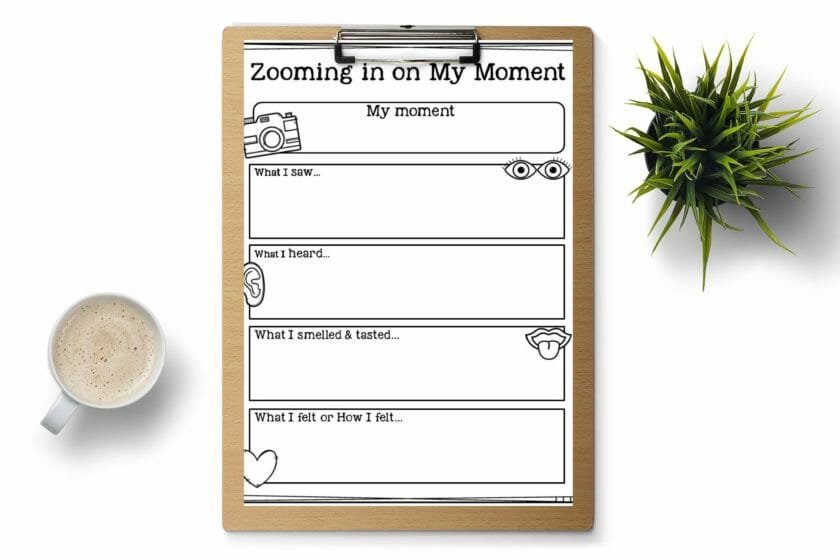
Use Sensory Details to Enrich Writing
Having students pause to visualize and record the sensory details of their small moment pays off in a big way. Not only does it help them get started, but it also gives them a strong reference point for revising and editing later.
Students can use a simple web or another type of organizer—the format doesn’t matter as much as making sure they slow down and really replay the moment in their minds. Plan for this to take a full writing period, because the richer the prewriting, the stronger the drafts will be.
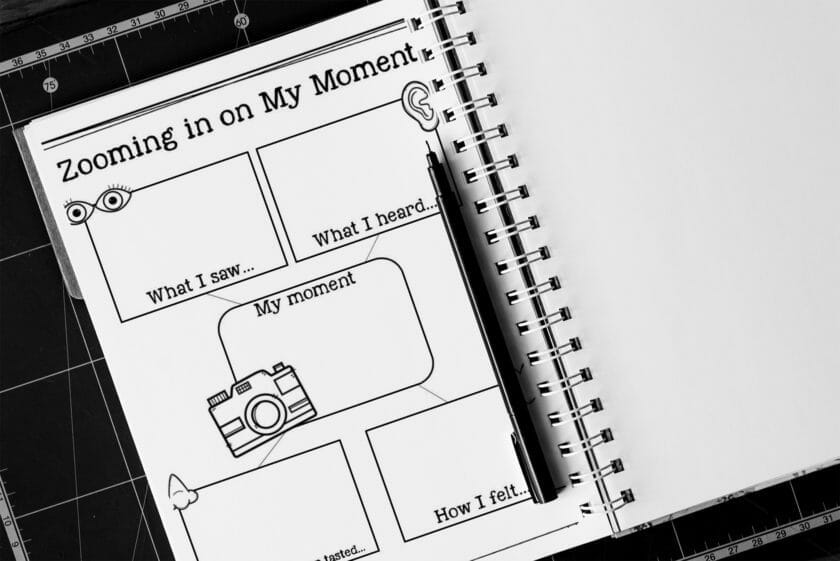
Help students write a step-by-step plan
After students have replayed their small moment in their minds, it is time to get those ideas on paper. Without structure, many will slip right back into writing list stories.
Teaching them to make a simple plan helps them see the flow of their story and gives them confidence before drafting. I like to have students sketch out their story as part of this step. Their drawings often capture small details we can use later to add depth to their writing.
We then use this organizer to move into drafting. For younger students, that might mean a single paragraph or two. Older students usually expand each section of the organizer into its own paragraph.
Teacher Tip: Have students add a few labels or short phrases to their sketches. This helps them remember the details they wanted to capture and makes the transition from picture to paragraph much smoother.
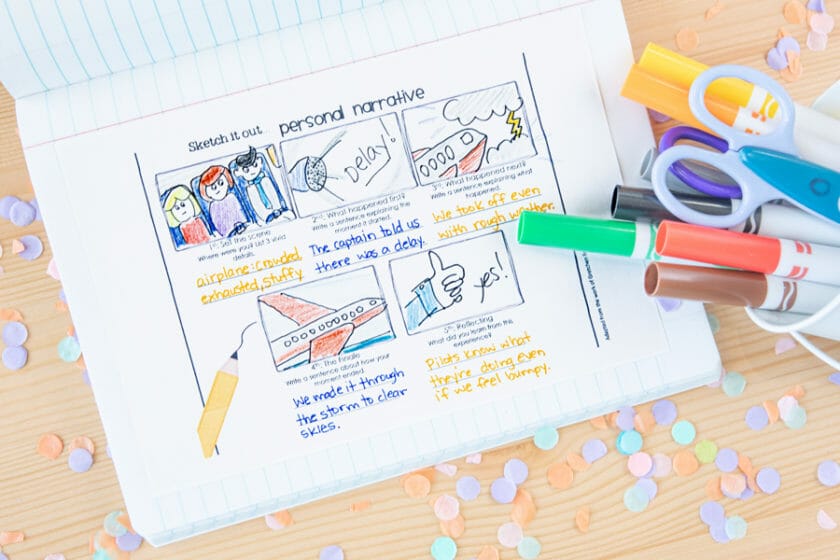
Books to help you teach personal narrative writing
Mentor texts are powerful tools for teaching personal narrative because they show students how published authors use the same strategies we want them to try. I’m picky about the books I choose—I want stories that are engaging, easy for kids to follow, and filled with rich, descriptive language.
Here are some of my favorite go-to picture books for this unit:
- The Relatives Came by Cynthia Rylant
- Fireflies by Julie Brinklow
- Roller Coaster by Marla Frazee
- Shortcut by Donald Crews
- A Moment in Time by Jennifer Butenas
15 Quick Small Moment Story Ideas
One of the biggest things I’ve found is that studnets hate writing about the same things year after year. You’ll want to find ways to keep your topics fresh and fun.
If you’re looking for some quick ideas for your next topic to write about, here are some small moment story ideas to get your writers started.
- Write about a time you felt really proud of yourself.
- Write about a time when you were surprised by something good that happened to you.
- Write about a time when you had to be brave.
- Write about a time when you made a new friend.
- Write about a time when you did something you were scared to do.
- Write about a time when you accomplished something you didn’t think you could do.
- Write about a time when you felt really happy.
- Write about a time when you helped someone.
- Write about a time when you felt really proud of your family or friends.
- Write about a time when you felt really embarrassed.
- Write about a time when something really funny happened to you.
- Write about a time when you were bored and what you did to entertain yourself.
- Write about a time when you were really mad at someone.
- Write about a time when you were really sad.
- Write about a time when you had to apologize to someone.
Grab Free Graphic Organizers to Get Started
To make things easier, I’ve put together a free set of graphic organizers you can use right away in your personal narrative unit.
Inside, you’ll find tools that help students:
- Focus big events into small, story-worthy moments
- Record sensory details to bring their memories to life
Grab your free set today and save yourself planning time while giving your students a clear path into narrative writing.






